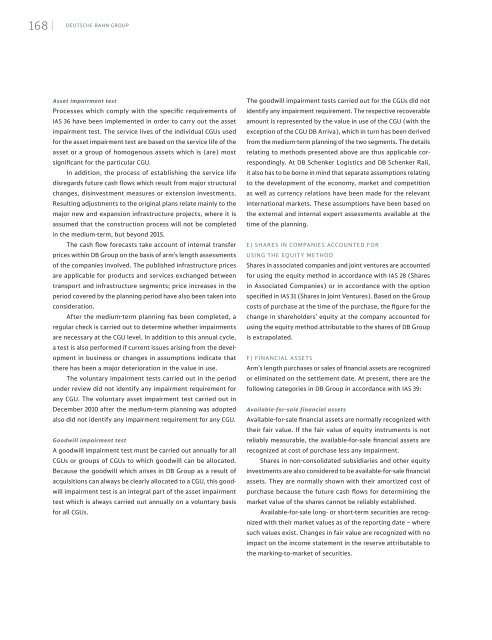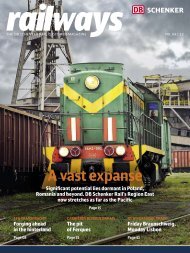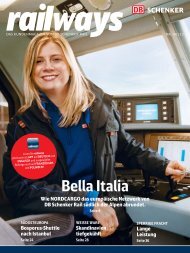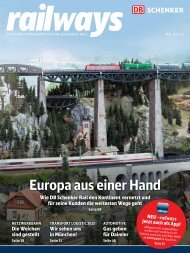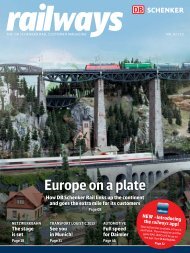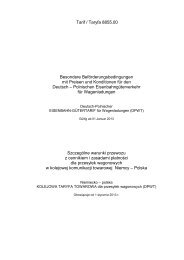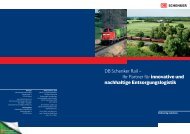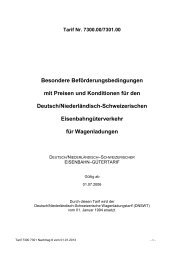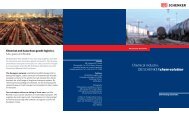Deutsche Bahn 2010 Annual Report - Deutsche Bahn AG
Deutsche Bahn 2010 Annual Report - Deutsche Bahn AG
Deutsche Bahn 2010 Annual Report - Deutsche Bahn AG
Create successful ePaper yourself
Turn your PDF publications into a flip-book with our unique Google optimized e-Paper software.
168<br />
| DEUTSCHE BAHN GROUP<br />
Asset impairment test<br />
Processes which comply with the specific requirements of<br />
IAS 36 have been implemented in order to carry out the asset<br />
impairment test. The service lives of the individual CGUs used<br />
for the asset impairment test are based on the service life of the<br />
asset or a group of homogenous assets which is (are) most<br />
significant for the particular CGU.<br />
In addition, the process of establishing the service life<br />
disregards future cash flows which result from major structural<br />
changes, disinvestment measures or extension investments.<br />
Resulting adjustments to the original plans relate mainly to the<br />
major new and expansion infrastructure projects, where it is<br />
assumed that the construction process will not be completed<br />
in the medium-term, but beyond 2015.<br />
The cash flow forecasts take account of internal transfer<br />
prices within DB Group on the basis of arm’s length assessments<br />
of the companies involved. The published infrastructure prices<br />
are applicable for products and services exchanged between<br />
transport and infrastructure segments; price increases in the<br />
period covered by the planning period have also been taken into<br />
consideration.<br />
After the medium-term planning has been completed, a<br />
regular check is carried out to determine whether impairments<br />
are necessary at the CGU level. In addition to this annual cycle,<br />
a test is also performed if current issues arising from the development<br />
in business or changes in assumptions indicate that<br />
there has been a major deterioration in the value in use.<br />
The voluntary impairment tests carried out in the period<br />
under review did not identify any impairment requirement for<br />
any CGU. The voluntary asset impairment test carried out in<br />
December <strong>2010</strong> after the medium-term planning was adopted<br />
also did not identify any impairment requirement for any CGU.<br />
Goodwill impairment test<br />
A goodwill impairment test must be carried out annually for all<br />
CGUs or groups of CGUs to which goodwill can be allocated.<br />
Because the goodwill which arises in DB Group as a result of<br />
acquisitions can always be clearly allocated to a CGU, this goodwill<br />
impairment test is an integral part of the asset impairment<br />
test which is always carried out annually on a voluntary basis<br />
for all CGUs.<br />
The goodwill impairment tests carried out for the CGUs did not<br />
identify any impairment requirement. The respective recoverable<br />
amount is represented by the value in use of the CGU (with the<br />
exception of the CGU DB Arriva), which in turn has been derived<br />
from the medium-term planning of the two segments. The details<br />
relating to methods presented above are thus applicable correspondingly.<br />
At DB Schenker Logistics and DB Schenker Rail,<br />
it also has to be borne in mind that separate assumptions relating<br />
to the development of the economy, market and competition<br />
as well as currency relations have been made for the relevant<br />
international markets. These assumptions have been based on<br />
the external and internal expert assessments available at the<br />
time of the planning.<br />
E) SHARES IN COMPANIES ACCOUNTED FOR<br />
USING THE EQUITY METHOD<br />
Shares in associated companies and joint ventures are accounted<br />
for using the equity method in accordance with IAS 28 (Shares<br />
in Associated Companies) or in accordance with the option<br />
specified in IAS 31 (Shares in Joint Ventures). Based on the Group<br />
costs of purchase at the time of the purchase, the figure for the<br />
change in shareholders’ equity at the company accounted for<br />
using the equity method attributable to the shares of DB Group<br />
is extrapolated.<br />
F) FINANCIAL ASSETS<br />
Arm’s length purchases or sales of financial assets are recognized<br />
or eliminated on the settlement date. At present, there are the<br />
following categories in DB Group in accordance with IAS 39:<br />
Available-for-sale financial assets<br />
Available-for-sale financial assets are normally recognized with<br />
their fair value. If the fair value of equity instruments is not<br />
reliably measurable, the available-for-sale financial assets are<br />
recognized at cost of purchase less any impairment.<br />
Shares in non-consolidated subsidiaries and other equity<br />
investments are also considered to be available-for-sale financial<br />
assets. They are normally shown with their amortized cost of<br />
purchase because the future cash flows for determining the<br />
market value of the shares cannot be reliably established.<br />
Available-for-sale long- or short-term securities are recognized<br />
with their market values as of the reporting date – where<br />
such values exist. Changes in fair value are recognized with no<br />
impact on the income statement in the reserve attributable to<br />
the marking-to-market of securities.


